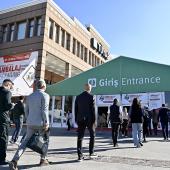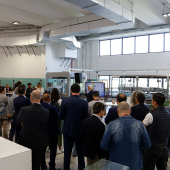IPACK-IMA 2025: how it’s changing

In the light of the European rules which are changing the reference landscape, Simone Castelli, CEO of Ipack Ima Srl, gives ItaliaImballaggio a preview of what we can expect from the 2025 edition of IPACK-IMA (and thereafter). Its role as an integrated and interconnected exhibition platform for processing and packaging, in which technology excellence meets innovation is, in the meantime, confirmed.

The recent revision vote of the PPRW has established a series of important restrictions on the packaging market, also allowing exceptions, however, for countries with a high recycling percentage. What’s your view of the current situation?
After the vote in Parliament in November, in which there was a more open attitude to the role of packaging, the Trilogue went in the direction once more of a more closed approach. Considering the prohibition of disposable plastic and bags with a thickness less than 15 microns, there will inevitably be an impact, especially on producers of materials, but also on machine manufacturers, who will have to redefine their strategies on the basis of new market demands.
And while the European institutions have opened a window with the exclusion of disposable products for fresh processed products such as salad, essential packaging for ensuring food safety and shelf-life or cardboard for fast food and take-away purposes, the latter sector is required to open up to the reuse of containers, which will be a big organizational challenge, with evident concerns about consumers’ safety. Logistics, which has worked with the packaging world on the reduction of weight and dimensions, is called on to find new forms of optimization with a further reduction in empty spaces and the reduction of volumes to a minimum. In addition, the push towards returnable bottles is a debatable solution if we consider the CO2 emissions into the atmosphere due to transport which only the definition of a shared model can measure correctly. As a sector we are convinced that there are data and calculation methodologies to define sustainability and not ideology.
The challenges are many, including the fragmentation of the single market, given the numerous exceptions provided for which, on the one hand, award nations stronger in recycling like Italy, exempting them from some obligations and, on the other hand, require machine and material manufacturers to adapt to differences between one market and another also inside the European Union where, instead, the focus for years has been on harmonization, a cornerstone of the Single Market.
The themes covered by the PPWR include bioplastics and biomaterials that represent a substantial share of the packaging of the future…
As IPACK-IMA has shown for some years, the world of packaging machines works today with new materials, being actively involved in their development, looking for the best possible solutions for packaging lines, in a close relationship with producers of traditional, recycled, recyclable and bio-based materials. The Commission intends to keep a communication channel on technological evolution in this sector constantly open in order to identify the best solutions in terms of packaging sustainability. In this evolving context, IPACK-IMA is an ideal meeting place for the industrial world in the sector, promoting dialogue not only between material and machine manufacturers, but also with the European institutions and stakeholders.
All these parties will find in IPACK-IMA in 2025 and in the years to come, the ideal business ecosystem for bringing the sectors into dialogue and encouraging a positive evolution that takes account of consumer safety, product preservation and a reduction of food waste. They are aspects in which packaging is a protagonist because it’s the expression of a sustainability approach which is increasingly able to consider all the components of the supply chain, from the environment to people, from the economy to health”
The world of packaging and processing meets together in the trade fair, but the evolution of Ipack-Ima will see it increasingly as a protagonist with an innovative formula able to a market undergoing a significant transformation precisely as a result of the revision of the PPWR and the definition of the 2030-2040 milestones in terms of recycling and reuse. Can you tell us how IPACK-IMA aims to be a protagonist in this change?
We are already today witnessing a decisive paradigm shift in the trade fair world, precisely as a result of an increased need to follow a market in continuous transformation. IPACK-IMA, however, has the advantage of being an expression of an industrial sector, represented by UCIMA and Fiera Milano, able to have a privileged understanding of the packaging and processing market of the various sectors. And let’s not forget in this context the strong relationship with the market and its operators, the continuing partnership with “The Innovation Alliance” project, and the three associated trade fairs, Print4All, Intralogistica and GreenPlast, which are able to offer an authentic overview of the related supply chains of instrumental mechanics.
The decision to move beyond the concept of a generalist trade fair is guiding us in the transformation of the fair into a point of reference of the sector as well as an ideal venue where to discuss the major issues of the industry and the regulatory framework to which it is subject. We therefore look with confidence to a model that goes beyond the three-year frequency that is no longer suitable for interpreting the transformations in progress with respect to technologies and the market. From 2025 onwards, therefore, IPACK-IMA will move in the direction of a series of trade fair events linked to and focused on individual product sectors, which will guide exhibitors more consistently over time, interpreting with them and for them technological developments and market trends up to 2028.




















